You'll find the best hours to prepare meals in sunlight occur between 7 AM and 4 PM, with peak efficiency from 10 AM to 2 PM. Start with the gentle morning light at sunrise for slow cooking and baking tasks, then shift to higher-temperature cooking as the sun intensifies. The sweet spot hits between 11:30 AM and noon, reaching ideal temperatures of 300-320°F. For desert environments, you can extend cooking into late afternoon, while summer months offer expanded windows, especially during the solstice. Your cooking success depends on understanding how these solar windows align with different cooking techniques and regional conditions.
The Golden Morning Hours
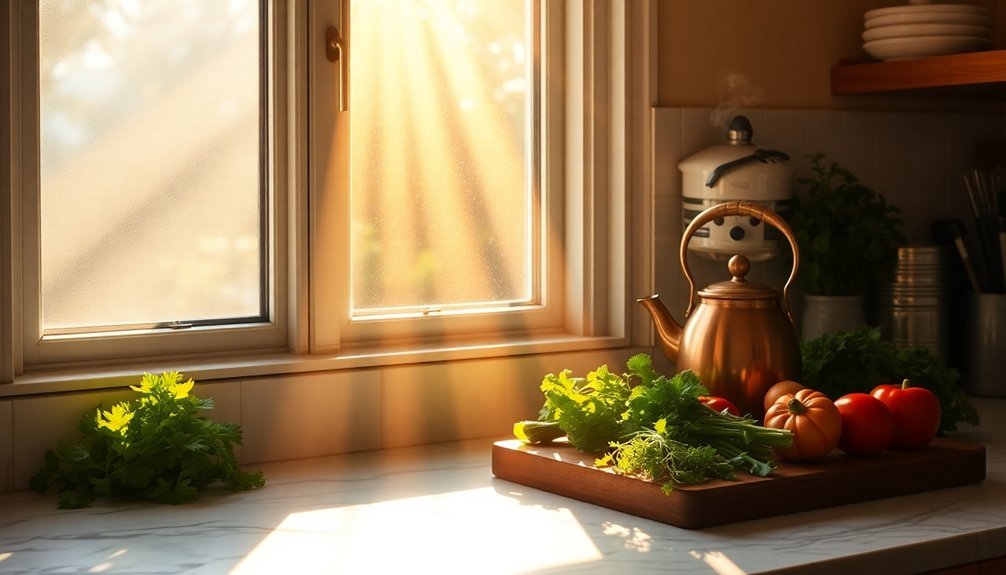
During the early morning hours, when the sun sits just below the horizon, you'll experience what photographers call the "golden hour." This magical period bathes everything in soft, warm light that's perfect for meal preparation and photography alike.
You'll find this golden period typically occurs when the sun is 4-6 degrees below the horizon, creating an ideal environment for kitchen activities. The gentle, diffused light won't cast harsh shadows on your workspace, making it easier to see the true colors and textures of your ingredients.
While the duration varies by season and location, you can make the most of this time by planning your meal prep accordingly. During this time, consider incorporating Lions Mane mushroom into your morning routine to enhance mental clarity as you start your day. If you're near water or in a humid area, you'll notice even more dramatic lighting effects that can enhance your cooking experience.
Peak Solar Performance Time
You'll find the most powerful solar cooking window between 10am and 2pm, when the sun's intensity reaches its peak at 1,000 watts per square meter.
Research shows this timing aligns with peak solar performance for energy generation from panels.
For best results, position your solar cooker by mid-morning to take advantage of the increasing solar radiation as the sun climbs higher in the sky.
Starting your meal preparation before lunch allows you to harness maximum heat during these prime hours when sunlight travels the shortest path through the atmosphere.
Noon For Maximum Heat
The ideal time for solar cooking arrives at high noon, when the sun reaches its zenith and delivers maximum heat intensity.
You'll find your solar cooker performing at its peak between 11:00 am and 3:00 pm, as the sun's rays hit Earth at their most direct angle during these hours.
To maximize your cooking efficiency, you'll need to adjust your solar oven's position throughout this window to track the sun's movement.
Using dark-colored pans and transparent lids will help trap heat inside your cooker. Cold air conditions with low humidity levels can actually enhance solar cooking effectiveness even during winter months.
During this prime period, you can tackle more demanding dishes like bread and cakes, while slower-cooking meals like stews and soups can simmer at lower temperatures.
Remember that your location matters – you'll get more consistent results in places like Las Vegas with six peak sun hours than in cloudier regions like Oregon.
Before-Lunch Cooking Window
Around mid-morning, solar cooking enthusiasts should begin preparing their meals to take full advantage of peak sunlight hours.
You'll want to start positioning your solar cooker by 11:00 am when UV ray intensity begins to climb. This timing lets you harness the most effective cooking window before peak heat arrives at noon.
During these pre-lunch hours, your solar oven can reach temperatures between 200°F and 300°F, making it perfect for starting slow-cook dishes like stews and soups. Most recipes will need double the cooking time compared to traditional ovens.
You'll need to use dark, thin-walled pots with tight-fitting lids to maximize heat absorption. Remember to adjust your cooker's position to track the sun's movement and check food temperatures with a cooking thermometer.
For best results, place your cooker where it won't be shadowed by buildings or trees.
Mid-Morning Sun Positioning
Maximizing your solar cooker's performance during mid-morning requires precise positioning and timing. You'll want to face your cooker easterly around 9:00-10:00 a.m., ensuring the shadow falls directly behind the unit for ideal sunlight capture.
| Time | Position | Action |
|---|---|---|
| 9:00 AM | East-facing | Initial setup |
| 10:00 AM | Southeast | Check shadow alignment |
| 11:00 AM | South-southeast | Adjust front flap |
| Noon | South | Reposition if needed |
Select a spot with continuous sunshine and protection from wind. Remember to check that your location isn't affected by shadows from nearby structures or trees. As you position your cooker, wear protective eyewear to guard against reflector glare. You'll achieve the best results when you maintain proper alignment throughout the cooking period, adjusting the front flap as the sun moves across the sky.
Midday Solar Sweet Spot
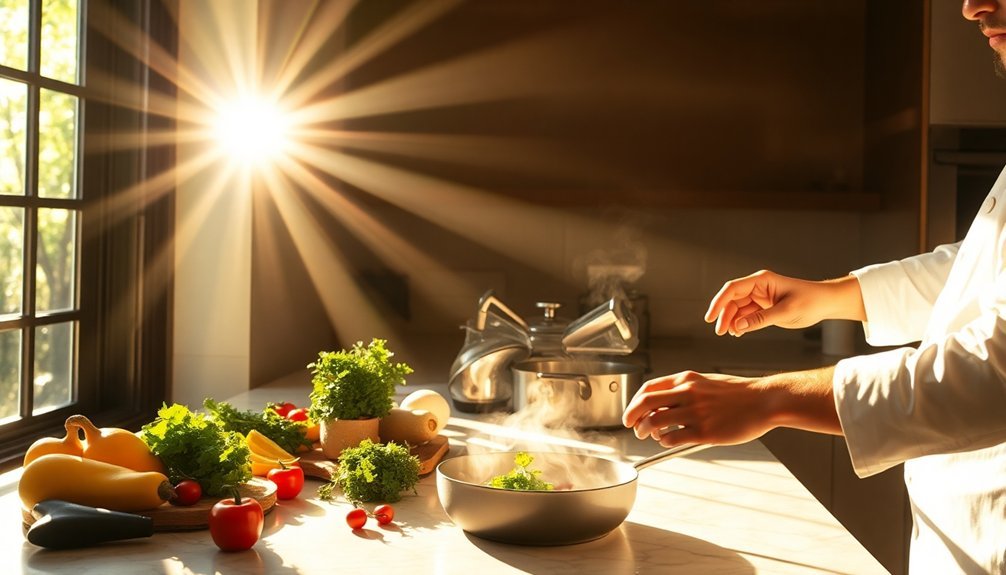
During peak daylight hours between 10am and noon, your solar cooking efforts will yield the best results.
You'll find temperatures climbing steadily from your 10am preheat, reaching ideal levels of 300-320°F by 11:30-12:00. This midday sweet spot provides maximum sunlight exposure for efficient cooking.
You won't need many positioning adjustments during summer months, but fall, winter, and spring require more frequent alignment checks to maintain even exposure.
To maximize your cooking success, preheat your pans and oils before adding ingredients, and resist opening the oven unnecessarily to maintain heat.
While the temperature may fluctuate, your dishes will cook successfully as long as you maintain minimum heat thresholds.
This period is perfect for slow-cooked meals, marinated dishes, and even desserts like baked apples.
Best Desert Cooking Window
Desert environments offer unique advantages for solar cooking, with their reliable sunshine and minimal cloud cover extending the ideal cooking window beyond standard midday hours.
You'll want to equip your kitchen windows with Low-E glass to manage the intense desert heat while maximizing natural light for meal preparation. Consider installing cellular shades or faux wood blinds that you can easily adjust throughout the day.
For peak cooking conditions, you'll benefit from vinyl-framed windows that resist warping in high temperatures.
These frames, combined with Low-E glass, help maintain consistent indoor temperatures while you're cooking. The Duolite system lets you fine-tune light levels as the sun moves across the sky, giving you flexibility to prepare meals from mid-morning through late afternoon without excessive heat gain.
Early Afternoon Heat Zone
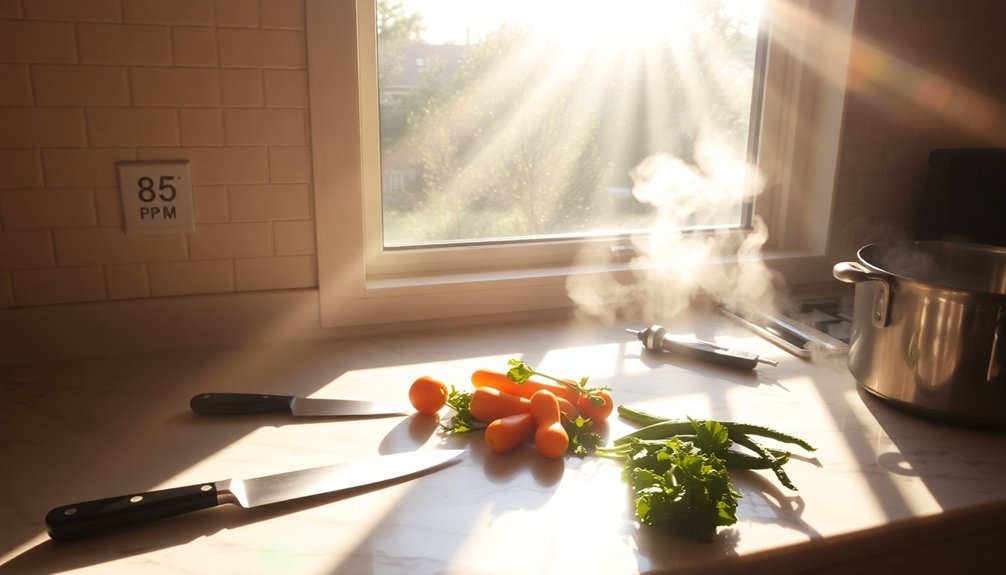
Through the peak hours of early afternoon, you'll find ideal conditions for mastering two-zone grilling techniques.
Stack your charcoal on one side of the grill for high-heat searing, while keeping the other side bare for indirect cooking. You'll want to light your coals using a chimney starter for consistent heat distribution.
Keep your lid closed to maintain steady temperatures and monitor them with a reliable thermometer. If you're cooking proteins, use the hot zone for searing steaks and burgers, then slide them to the cooler side for finishing.
You can enhance flavors by adding wood chunks and using a water pan to create humidity. Remember to keep your workspace organized and clean as you experiment with different coal arrangements to perfect your heat zone control.
Optimal Equatorial Cooking Period
While the sun reaches its peak intensity near the equator, morning hours from 8 AM to 11 AM offer the most favorable conditions for outdoor meal preparation.
You'll find the lower solar intensity during these hours provides even cooking temperatures without the risk of food spoilage that comes with midday heat.
During this ideal window, you can work comfortably in the cooler environment while taking advantage of the soft morning light for food preparation.
You won't need extra cooling measures, which makes your cooking more energy-efficient.
If you're photographing your dishes, the gentle morning sunlight will enhance their visual appeal.
The mild temperatures also make it easier to maintain proper food safety standards and keep your workspace clean and sanitized throughout your cooking session.
Summer Solstice Prime Hours
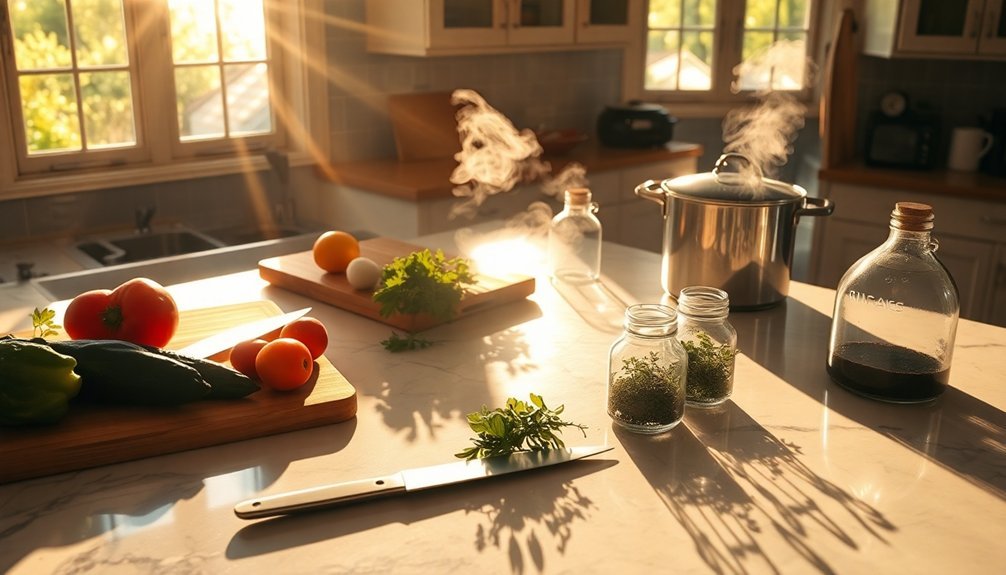
As summer solstice approaches on June 21, you'll find ideal cooking hours between 7 AM and 10 AM, when the extended daylight provides gentle yet consistent solar exposure. During the longest day of the year, you can maximize natural light for meal preparation, taking advantage of the sun's position and extended daylight hours.
| Time Period | Solar Cooking Benefits |
|---|---|
| 7AM – 8AM | Gentle morning rays, ideal for slow-cooking |
| 8AM – 9AM | Peak morning efficiency, perfect for baking |
| 9AM – 10AM | Maximum heat retention, suits grilling |
| 10AM – 11AM | Strong direct sunlight, best for quick cooking |
You'll want to prepare your cooking setup before the atmospheric heat lag peaks later in the day. This timing aligns with traditional agricultural practices and helps you harness prime sunlight conditions for food preparation.
High Temperature Cooking Range
Once you've mastered basic solar cooking techniques, you'll discover that different solar cooker designs offer varying temperature ranges for diverse cooking methods.
Panel cookers can reach boiling temperatures, making them perfect for rice, meats, and vegetables, while parabolic reflectors can achieve an impressive 500°F for frying and grilling.
You'll get the best results on clear sunny days, when temperatures can reach 250°F in most solar cookers.
If you're dealing with partial clouds, expect temperatures between 200-250°F and plan for longer cooking times.
To maintain these high temperatures, use black pots or barbecue grill paint on regular cookware, and always place your cooker directly facing the sun.
Don't forget to check your cooker every 20 minutes and adjust its position to track the sun's movement.
Maximum Solar Energy Time
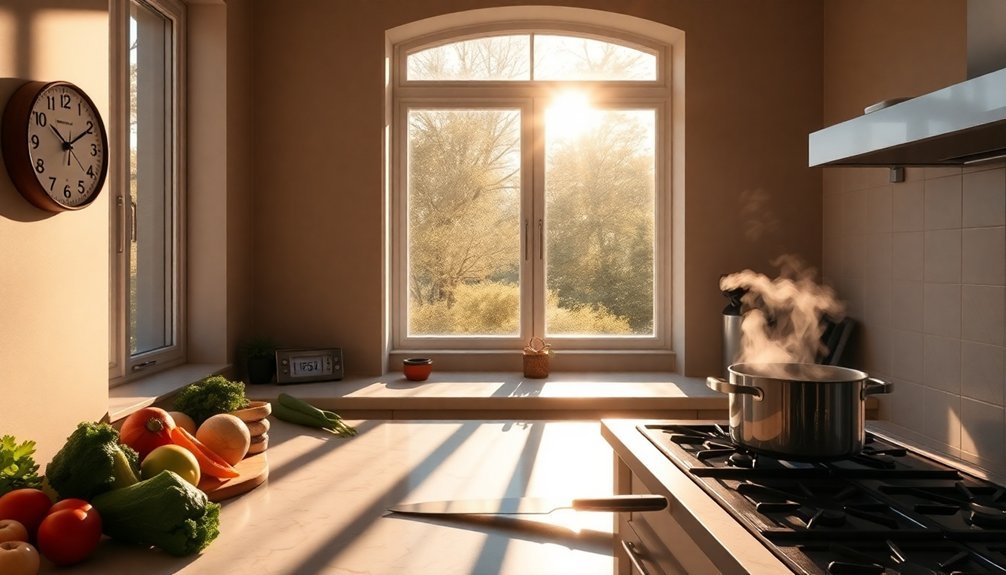
To maximize your solar cooking potential, you'll want to schedule meal preparation between 11:00 AM and 3:00 PM when the sun's energy peaks. During this window, the sun's direct overhead position provides the most intense solar energy for efficient cooking.
You'll need to adjust your cooker more frequently in winter months when days are shorter and sun intensity is lower.
Even on days with thin cloud cover, you can still cook successfully, though you may need to extend your cooking time.
If you're in regions like Southern Arizona or Texas, you'll benefit from consistent sunlight year-round.
However, if you live in cloudier areas like Oregon or Washington, you'll face more challenges getting consistent results.
For best performance, position your cooker to face directly into the sun and adjust it every one to two hours.
Sunny Season Perfect Hours
Building on the sun's peak energy patterns, sunny season cooking offers extended opportunities beyond the standard midday window. You'll find ideal cooking conditions between 10 AM and 4 PM, with peak efficiency around noon when sunlight intensity reaches its maximum.
To maximize your solar cooking success, choose days with clear skies and temperatures above 30°C (86°F).
You'll want to set up your cooking station in a spot that receives full sun exposure while staying protected from strong winds. Use dark-colored pots with lids to absorb more solar energy, and make sure your panel or box cooker is properly insulated.
Keep humidity levels below 60% for the best results, and remember to monitor your food regularly. If you're closer to the equator, you'll benefit from even more cooking hours due to the sun's higher path.
Frequently Asked Questions
Can I Use Aluminum Foil to Enhance Solar Cooking Efficiency?
Yes, you'll find aluminum foil highly effective for solar cooking. It reflects up to 95% of sunlight, focusing heat onto your food. Just remember you'll need to replace it periodically as it fades with sun exposure.
How Do Wind Conditions Affect Solar Cooking Times?
Wind can markedly slow down your solar cooking times, often doubling or tripling them. You'll notice temperatures dropping dramatically, especially in 25mph winds. Using windbreaks and sheltered locations will help maintain cooking efficiency.
What Happens if Food Isn't Fully Cooked by Sunset?
If your food isn't fully cooked by sunset, you'll need to finish it using conventional methods. Don't risk eating undercooked food – transfer it to your stove or oven to reach safe temperatures.
Should Food Be Stirred or Rotated During Solar Cooking?
You don't need to stir food while solar cooking since it cooks evenly on its own. However, you'll want to rotate the solar cooker itself every 20 minutes to follow the sun's position for ideal results.
Can Winter Snow Reflection Increase Solar Cooking Effectiveness?
While snow can reflect sunlight, it won't greatly boost your solar cooking effectiveness. You'll still face winter challenges like shorter days, weaker sun angles, and colder temperatures that reduce your cooker's performance.
In Summary
You'll get the most out of solar cooking by planning your meal prep during these ideal daylight hours. Whether you're choosing the intense midday sun or the steady morning rays, timing is essential for success. Remember to adjust these windows based on your season and location. By following these peak solar cooking times, you'll maximize efficiency and create perfectly sun-cooked dishes every time.

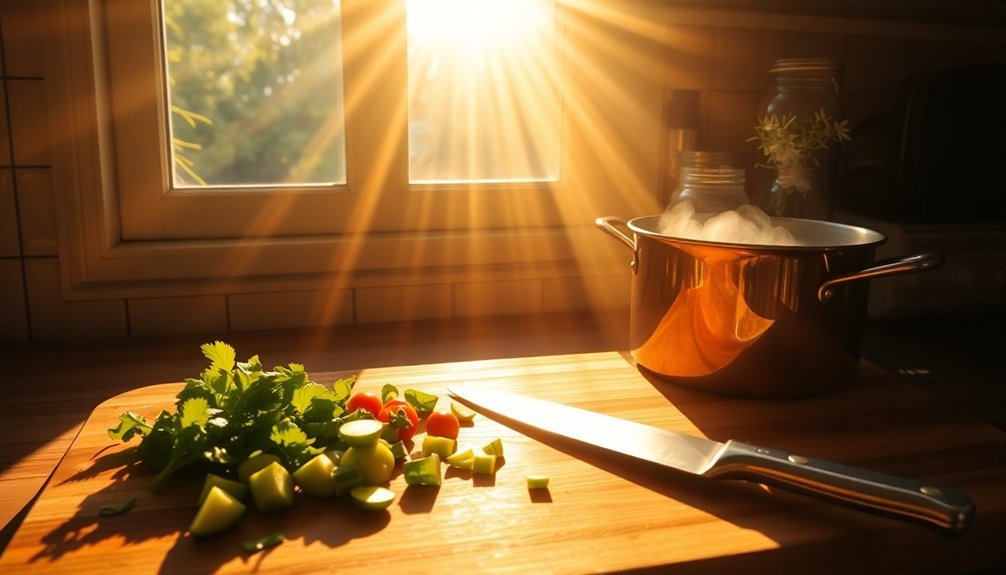



Leave a Reply